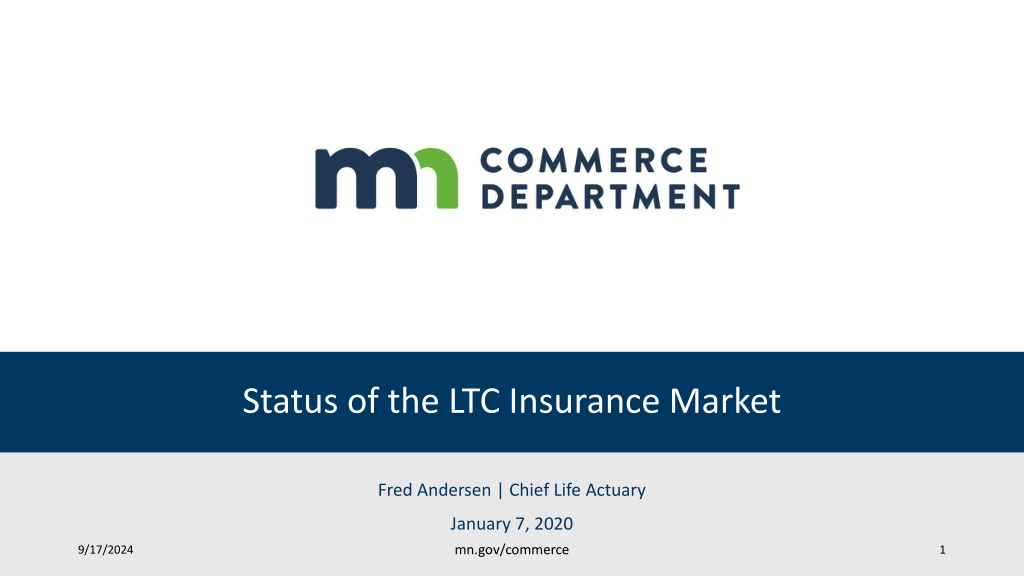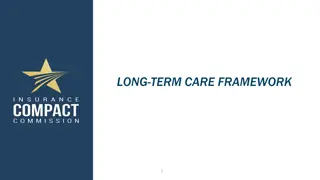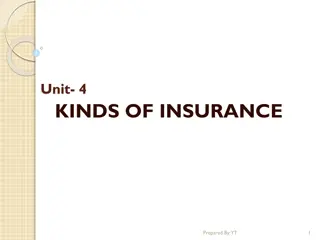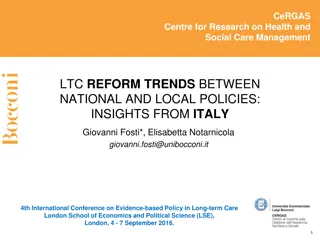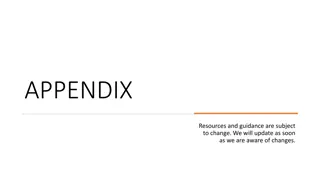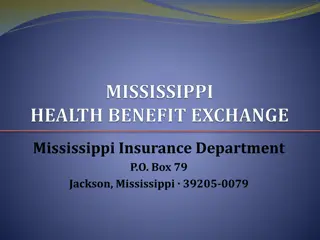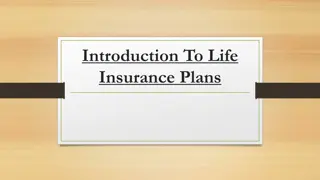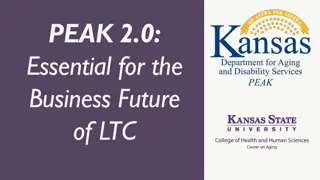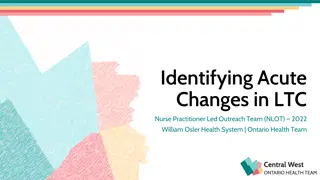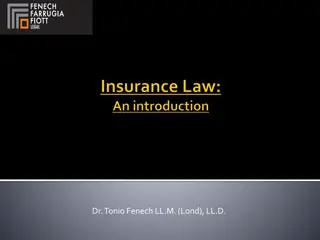Understanding the LTC Insurance Market Trends
Explore the current landscape of Long-Term Care (LTC) insurance, focusing on the financial challenges faced by aging baby boomers and the role of LTC insurance in addressing these issues. Learn about the average age for LTC needs, the financial impact, coverage options, and the importance of planning for long-term care costs in the aging population.
Download Presentation

Please find below an Image/Link to download the presentation.
The content on the website is provided AS IS for your information and personal use only. It may not be sold, licensed, or shared on other websites without obtaining consent from the author. Download presentation by click this link. If you encounter any issues during the download, it is possible that the publisher has removed the file from their server.
E N D
Presentation Transcript
Status of the LTC Insurance Market Fred Andersen | Chief Life Actuary January 7, 2020 mn.gov/commerce 9/17/2024 1
Outline Aging baby boomers and financial picture Past and present LTC insurance How the insurance product works New product design what is and is not covered Comparison with other LTC funding approaches Role of private insurance in overall LTC system 2
Baby Boomers Financial Picture Average age of person starting to need LTC is 78 Need for LTC is defined as inability to perform at least 2 activities of daily living Bathing, dressing, feeding, etc. Or severe cognitive issue (Alzheimer s / Dementia) Care is not covered by Medicare or other health insurance 3
Financial Picture Continued Most common initial care is by daughters Time away from career, spouse, kids, activities Stressful financially and mentally/emotionally When conditions become more severe, help is needed and it is costly Home care, assisted living , nursing home care Can cost well in excess of $150/day or $50,000/year 4
Financial Picture Continued 10% of those 65+ have LTC insurance For the 90% without insurance, savings used until depleted Without insurance and after savings is depleted, Medicaid pays for LTC Medicaid is intended to provide health care for the poor Baby boomers are aging Number relying on Medicaid for LTC is increasing; therefore LTC-related Medicaid costs are growing at an unsustainable pace Without change: Bankrupt households and governments 5
How LTC Insurance Works Average issue age: 55-60 Average premium: $200/month Average age of first claim: 75-80 Range of benefits Cover home health, assisted living, nursing home Daily benefits ($100 - $200) Inflation protection $100 - $200 inflates at 5% per year or zero inflation to cover increasing cost of care Lifetime vs. limited (e.g., 3 years) 6
Past and Present LTC insurance 1990-2005 Affordable products that cover all LTC costs Pricing based on expectations of life expectancy, lapses, length of claims, investment returns Lifetime benefits increasing at high inflation Increasing sales Significant source of LTC funding for many Americans 7
Past and Present LTC Insurance Then, several factors reversed this trend Life expectancy increased over expectations More people reached age 78 than expected Fewer lapses of policies than expected People saw value in this product Lengthier claims than expected Mainly due to Alzheimer s Lower investment returns than expected Difficult to support inflationary benefits 8
Past and Present LTC Insurance 2006-present Rate increases on existing products LTC contracts allow companies to request rate increases Reasons are losses generated by factors being worse than expected Original pricing was lower due to flexibility for future increases 9
Past and Present LTC Insurance 2006-present Costlier new products Fewer lifetime benefit and inflation-adjusted products With losses and lower sales, most companies stopped selling LTC insurance Around 12 are left mainly mutual and fraternal insurers (such as Northwestern Mutual & Thrivent) If priced correctly, it s not a money loser Profit-centric companies tend to be scared by negative stigma & want to protect their stock prices 10
Viability of stand-alone LTC insurance Noting problems for consumers and companies, is stand-alone LTC insurance still viable? Under certain circumstances, yes Less uncertainty about pricing Strong, diverse companies selling the product Certain affordability and risk appetite for consumers Comparison with different LTC financing approaches: 9/17/2024 mn.gov/commerce 11
Insurance vs. Investment Stand-alone LTC can be the least expensive way to finance a substantial LTC event. It can also lead to no benefits resulting from years of paying premiums. Similar to fire insurance if your house doesn t burn down, there s no insurance claim. 12
Insurance vs. Investment Most inexpensive LTC funding has insurance aspect If no LTC needed, no money is received in return Most expensive LTC funding has investment aspect If no LTC needed, money may be returned to policyholder or beneficiary Key: the investment aspect is often desirable, but it is expensive A reason why a variety of LTC insurance products are available Based on needs and affordability 13
Insurance impact on Medicaid Most Medicaid money goes to long-duration, severe claims With new private LTC insurance covering mainly short-duration claims (less than 4 years), Medicaid costs are not helped as much Takeaway: more insurance coverage does not necessarily mean substantially lower Medicaid costs 14
Alternative private LTC insurance financing Variety of combination products Accelerated benefit on life insurance Riders to extend LTC coverage If more costly than the life insurance death benefit Combination with annuities Most of these products have higher initial or higher monthly premiums than stand-alone LTC products However, with most of these products, the policyholder or beneficiary is guaranteed to get money in return Even if no LTC event 15
Alternative private LTC insurance financing Most combo products: great if you can afford them Low risk for insurance companies, too With standalone pricing assumes many people get nothing in return Many people assumed to lapse, die before claim, die or recover soon after claim Difference in percentage who eventually go on claim has substantial financial impact on the block and company With many combo products, claim is always paid LTC, death benefit, or annuity Timing differences have lower risk than claim or no-claim outcomes 16
Math Funding LTC needs Initial monthly outlay Little/No LTC Moderate LTC High-case LTC Catastrophic LTC Standalone Insurance (3-year benefit) $ 200 $ 200 $ 200 $ 1,200 Standalone Insurance (lifetime benefit) $ 300 $ 300 $ 300 $ 300 Combo / Accelerated Whole Life $ 450 $ 450 $ 450 $ 450 Savings for high-case LTC $ 600 $ 600 $ 600 $ 600 9/17/2024 mn.gov/commerce 17
Math Funding LTC needs Investment view Little/No LTC Moderate LTC High-case LTC Catastrophic LTC Standalone Insurance (3-year benefit) $60,000 spent no return $20,000 more in claims than premiums $100,000 more in claims than premiums Claims > premiums, then unmet need Standalone Insurance premiums (lifetime benefit) $90,000 spent no return $10,000 less in claims than premiums $70,000 more in claims than premiums $330,000 more in claims than premiums All money returned to beneficiary Some money for LTC, some for beneficiary Combo / Accelerated Whole Life Most money for LTC All money for LTC All money available to beneficiary Savings for high-case LTC Most money for LTC All money for LTC Unmet need 9/17/2024 mn.gov/commerce 18
Risks / uncertainty With stand-alone products, still risk Even with fewer 5% inflation, fewer lifetime benefit products, and updated assumptions on mortality and policyholder behavior With cheaper price but no guaranteed return (if die or lapse without a qualifying LTC event) Mis-estimating the number of people who will go on claims remains a risk 9/17/2024 mn.gov/commerce 19
Risks / uncertainty Four notable current areas of uncertainty: Will claims incidence improve over time? Varying factors that could shift incidence in either direction Environmental, health, and technological factors How will cost-of-care inflation compare to daily maximum benefit inflation included in many insurance policies? Will people noted as healthier-than-average during underwriting continue to be healthy? Claims data at older ages is relatively new & developing 9/17/2024 mn.gov/commerce 20
A variety of insurance products are needed Factors that differ by family: Nearby support from family and friends Informal help available during early LTC period? Trend: families more spread apart impacts LTC financing needs Affordability and view of insurance as pure insurance or investment Some prefer guaranteed returns Some prefer lower price 9/17/2024 mn.gov/commerce 21
LTC insurance product variety Stand-alone product differences: Elimination period From onset of qualifying LTC conditions Typical: 90 days Longer the EP, the lower the premium rate Maximum daily benefit Average around $150 Lower the maximum DB, the lower the premium rate 9/17/2024 mn.gov/commerce 22
LTC insurance product variety Stand-alone product differences: Inflation protection Helps ensure the maximum daily benefit keeps up with inflation Varies from 0% to 5% - trend is downward More focus today on affordability and low interest rate environment Lower the inflation protection, the lower the premium rate Benefit period Lifetime or limited Shorter the period, the lower the premium rate 9/17/2024 mn.gov/commerce 23
LTC insurance product variety Stand-alone product differences: 0-day EP, $200 daily benefit, 5% inflation, lifetime benefits may cost 5x-10x more than 180-day, $100 daily benefit, 0% inflation, 3-year benefits Many choices / many price points Other differences include expense reimbursement vs. cash indemnity Combination products Life insurance accelerated death benefit choice of benefit amount Common: $250,000, $500,000, $1 million Claims deduct from death benefit if qualifying LTC event claim always paid Rider can be purchased to extend LTC benefits beyond death benefit amount 9/17/2024 mn.gov/commerce 24
LTC insurance product variety Annuity combo products: similar concept Planning for retirement income and potential LTC needs Potential middle-market products Lower cost but typically pure insurance (events leading to claims don t occur in many instances) One example: LifeStage concept being developed details in later session Front-end, shorter-term coverage or High-deductible, back-end, catastrophic coverage 9/17/2024 mn.gov/commerce 25
Policyholder behavior Reaction to rate increases Companies typically provide a variety of options Default is to accept the rate increase and maintain full benefits Alternatives: Reduction of future inflation accumulation Reduction of maximum daily benefits Reduction of benefit period Timing of claims Some choose to go on claim at onset of LTC conditions Some wait, concerned about eventual expiration of benefits 9/17/2024 mn.gov/commerce 26
Details issues with current products Solvency concerns with some monoline insurance companies Caused mainly by long, expensive claims Particularly Alzheimer s / dementia claims Rate increases / options in lieu of increases National regulator efforts to mitigate negative impacts re: current products and help market for new products be as effective as possible 9/17/2024 mn.gov/commerce 27
Will increased private LTC insurance market result in Medicaid savings? Products covering back-end coverage are more likely to result in Medicaid savings Due to back-end cases costing more in Medicaid money than front-end services Any type of insurance will help people Example: short-term home health care benefit will help, e.g., after a fall Prevent life disruption for daughters / caretakers However, this will not impact Medicaid budgets as much as lifetime benefit products Programs that prevent LTC events could help Medicaid budgets 28
How State Government can help Public hearing / improvements in rate increase review process Affordable LTC products LifeStage and others high ded vs. upfront issues, insurance vs. savings Need variety of products to handle different life situations Affordability and family/friend support are important factors Education / Outreach Consumers and other stakeholders including public hearing 9/17/2024 mn.gov/commerce 29
Follow-up plans Consumer issues Receive feedback Rate action notification, agent education, and claims handling Rate increase review process Push for national standardization Minnesota will help ensure appropriate balance, protecting consumers, is included Educational documents re: managing LTC insurance policies DHS: Education on planning for LTC needs at earlier age Engage with all stakeholders
Summary Recognize role of various means of LTC financing Recognize concerns with current insurance products Help ensure stability and meet demand for new products Where appropriate, eliminate regulatory obstacles to helpful products 31
Thank You! Fred Andersen Frederick.andersen@state.mn.us 9/17/2024 mn.gov/commerce 32
